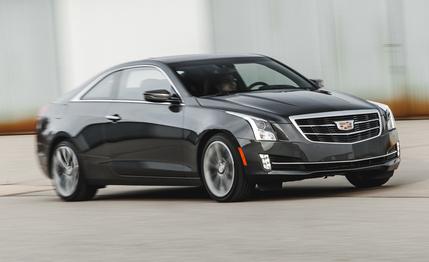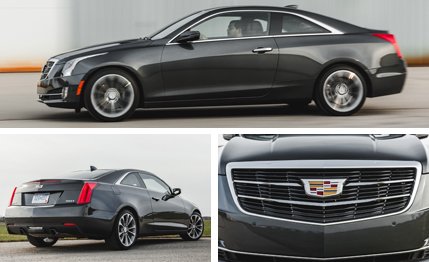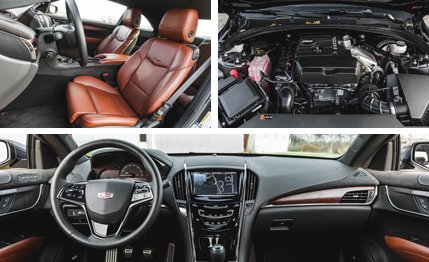
 Instrumented Test
Instrumented Test
If an automaker’s success really were just about the cars, as the industry shibboleth has it, Cadillac would be riding high. Take the object of this test, the new-for-2015 ATS coupe. It proved itself a worthy entry-luxury sports coupe by just about every measure imaginable, and it’s one of the most modest Cadillacs you can buy, packing a 2.0-liter turbo four with a six-speed manual gearbox in a compact two-door. Delightful to drive, well appointed, and properly built, it joins the CTS sedan (one of our 10Best Cars winners) as a world-class contender.
And yet, headline after headline is about how Cadillac is “struggling,” its sales volumes down, its leaders stirring new controversies with every pronouncement about how they’re going to “fix” things by moving the marketing team to New York, stripping the wreath from the crest on the badge, changing the naming scheme, pursuing an ambitious higher-price strategy, and investing heavily to expand the range of products. If the secret sauce is good cars, then what’s all that fuss about?
On the evidence of the ATS, Cadillac is making really good cars. Some great ones, even. Aside from its drivetrain, this example was no stripper: It arrived at the test track wearing the range-topping Premium trim, which lifts the MSRP from the base $38,990 to $48,090. Aside from the usual abundance of creature comforts and showy technologies that come with such a designation and another 91 Benjamins, the Premium trim brings GM’s Magnetic Ride Control variable suspension and a limited-slip differential, both useful contributors to the ATS’s superb handling and over-the-road performance.


At the track, the turbo-four/manual combo delivered a 0-to-60-mph run of 5.7 seconds, just 0.3 longer than achieved by the previously tested V-6/automatic ATS coupe, and finished the quarter-mile sprint in 14.1 seconds while doing 101 mph. Good numbers. It surrenders a half-second to 60 mph but finishes the quarter-mile in a dead heat with the BMW 428i that is the most direct competitor. And this ATS handily beat Munich’s base coupe in deceleration and roadholding by braking from 70 mph in only 156 feet and clawing the skidpad at 0.92 g.
When we pitted the 2.0-liter/manual-gearbox Cadillac and BMW sedans against one another in a comparison test, the BMW won but the Detroit entry’s engine has since been recalibrated and delivers a lot more torque earlier in the rev band. It still can’t match the easy-spinning eager personality of the BMW’s mill, but it lands a stronger punch. This coupe was but 2 pounds heavier than the sedan with the same drivetrain in that comparo and 86 pounds lighter than the V-6 ATS coupe. It all seems to have come off the front axle, as the balance shifts rearward from 52.0/48.0 percent with the six to 50.7/49.3 in this car.
And the coupe expands on the “fun to drive” elements we found most appealing in the sedan. It has a sweetly balanced, light and lively character with crisp turn-in response, a precise shifter that’s fun to use, brakes that are not only strong but reassuringly easy to modulate, and a controlled ride free of the excesses of roll, pitch, or head-toss.


No car is perfect, of course, and this one might have drawn more attention if the two-door looked a little less like the sedan, bolder and more daring. No one looks at a 4-series or an Audi A5 and says, “That looks just like the sedan without the rear doors.” Some say that about the ATS coupe, noting that the previous-generation CTS coupe was far more distinctive. It was also harder to see out of and the expressive design didn’t result in many sales, so this more conservative approach with the ATS is understandable. It might look better without a B-pillar, but so might the 4-series and the Lexus RC, and those, too, had to yield to the need for structural rigidity and side-impact safety.
There was only one extracost option on this example (the manual is a no-cost choice over the standard six-speed automatic): $1295 for the upgraded Kona brown leather with jet-black accents that dressed up the cabin. We liked it, but the standard cabin trimmings already meet high standards for materials and fit. The bottom line falling just shy of $50K reflects Cadillac’s conviction that premium-grade cars should wear premium-grade stickers. Some of us have opined that this strategy is a tad ambitious—or just plain too much. In this case, we spec’d out a 428i with equivalent equipment and rang up a $53,000 tab. No further comment.
Cadillac already builds cars as good as (or better than) those from German and Japanese luxury marques. Yes, it could stand for that accolade to spread across a wider range of its products, particularly in the crossover segment, but the past few years suggest that future models in the pipeline should do fine. And yet, there’s all that ill news in the wind. Success must not be only about the cars. If Cadillac has to pay more attention to dealers and marketing and brand-building, okay, so long as it keeps building cars like this ATS. Because making great cars is where it begins, and Cadillac has a strong running start.